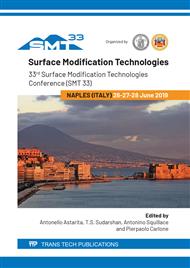p.228
p.234
p.241
p.248
p.254
p.261
p.267
p.273
p.279
Morphological and Chemical Characterization of Laser Treated Surface on Copper
Abstract:
Electron multipacting and electron cloud have been identified as being the major limiting factors for the beam quality or for the cryogenic system of high-intensity positive particles accelerators. Among conditioning operational techniques and other surface structuration techniques used to decrease the Secondary Electron Yield (SEY) of surfaces, laser surface treatment is a promising method to treat in situ and at atmospheric pressure copper surface of the vacuum chamber. Here, pulsed laser irradiation of copper in parallel lines pattern led to the local ablation and deposition of aggregates of copper particulates on the surface. Tests undertaken at CERN have shown that the modification of the surface morphology by creating roughness at different scales induces a decrease of the SEY by geometrical effects. Nevertheless, the mechanical strength and dust generation of the treated surface have not been addressed yet.In this work, a qualitative analysis of the multi-scale description of the surface morphology was carried out. Scanning Electron Microscopy (SEM), Focused Ion Beam (FIB), Transmission Electron Microscopy (TEM) and Energy Dispersive X-ray Spectroscopy (EDS) were used to investigate morphological characterization such as size and shape of the particulates, chemical composition, metallographic structures and phase transformation on the laser-processed surface.SEM and FIB examinations showed that the surface morphology depends on the local laser energy irradiating the surface and especially, relatively to the ablation threshold. TEM analysis revealed chemical composition and crystalline configuration of the treated material and helped to identify the laser modified and oxidized areas. A variety of superficial structures were observed. Potential vulnerable structures have been identified as oxidized matter redeposited on the ablated near surface. Material continuity and composition play a major role in the mechanical integrity of the generated surface morphology. The adherence of the created structures was assessed analyzing the origin of the dust extracted after mechanical stress.
Info:
Periodical:
Pages:
254-260
Citation:
Online since:
July 2019
Price:
Сopyright:
© 2019 Trans Tech Publications Ltd. All Rights Reserved
Share:
Citation:


